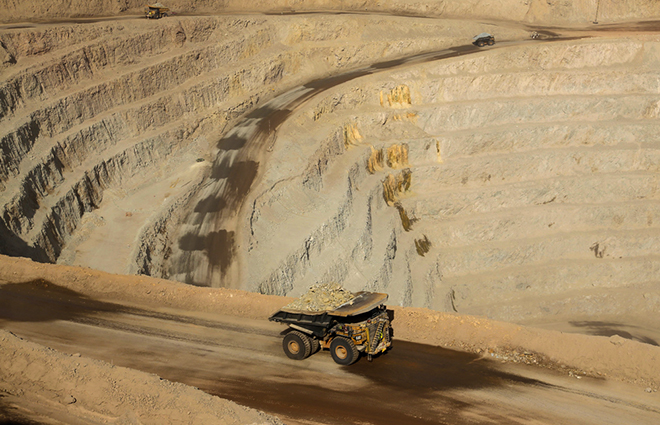S&P Global Offerings
Featured Topics
Featured Products
Events
S&P Global Offerings
Featured Topics
Featured Products
Events
S&P Global Offerings
Featured Topics
Featured Products
Events
Banking & Capital Markets
Economy & Finance
Energy Transition & Sustainability
Technology & Innovation
Podcasts & Newsletters
Banking & Capital Markets
Economy & Finance
Energy Transition & Sustainability
Technology & Innovation
Podcasts & Newsletters
S&P Global Offerings
Featured Topics
Featured Products
Events
6 Apr, 2022
By Anthony Barich

| Antofagasta's Centinela copper mine in the Antofagasta region of northern Chile, where hydrogen technology will be tested for use in mining trucks for the first time in the country. |
As part of the first pilot project in Chile to advance the use of hydrogen in large mining equipment, researchers are working on a stationary prototype that will be placed on site at Antofagasta PLC's Centinela copper mine. Erik Isokangas, the project's technical director, told S&P Global Commodity Insights the prototype is expected to launch in June, giving a clearer timeline from the previously announced target of 2022.
The Hydra consortium — made up of French utility Engie SA, Australian mining research organization Mining3, Mitsui USA, Thiess Pty. Ltd., Ballard Power Systems Inc., Hexagon Purus ASA and Chile's Reborn Electric Motors — has been working to replace the use of diesel in high-tonnage vehicles as part of the project, which commenced in April 2021.
Antofagasta will be the first mining company to install a pilot project in Chile to integrate hydrogen into large mining equipment, such as extraction trucks, according to an October 2021 release. Chile's authorities want hydrogen to power 87% of the country's 1,390 mining sector haulage trucks by 2050, BNamericas reported in the same month.
"The Hydra project seeks to replace the conventional diesel engine with a modular plug-in system made up of hydrogen fuel cells and batteries," Vicky Au of the Commonwealth Scientific and Industrial Research Organisation, or CSIRO, told the Global Iron Ore & Steel Forecast Conference in Perth, Western Australia, on March 30. CSIRO is the Australian government's national science agency, and Au is the engagement and strategy lead on its Hydrogen Industry Mission.
Engie and Mining3 are leading the project, with CSIRO's Chile office providing in-country support. Having completed the conceptual study, the consortium is now working on pre-feasibility and engineering studies of a propulsion system and the renewable hydrogen value chain, Au told delegates.
"This will include design and manufacture of a modular skid-based prototype composed of a 60-kilowatt fuel cell and 140-kilowatt-hour battery. The important part of this is that it's going to be tested in Chile under mining conditions" including altitude, dust and temperatures, Au said.
The prototype, a container-based structure akin to "a truck without wheels," will be placed near the pit at Centinela so it can face the conditions a truck would experience while remaining stationary, Isokangas of Mining3 told Commodity Insights.
"This is a really important stage for us to get through, because after that we will go to proof of concept, hopefully in 2023 — conversion of a 2-megawatt diesel engine mining truck into a fully electric fuel cell and battery powered truck," Au told conference delegates.
This truck will have a daily hydrogen consumption equivalent to between 800 kilograms and 1,000 kilograms. If it is successful, the consortium will scale up to more vehicles in 2025, Au said.
Bringing down costs
CSIRO sees mobility as an initial target market for hydrogen use in metals and mining, as the technology is an "early win" for companies to start demonstrating a pipeline of decarbonization options, particularly compared with "harder to abate" complex systems like blast furnaces for steelmaking, Au told Commodity Insights.
While the availability of coal and gas still makes them far cheaper than hydrogen to power mining equipment, hydrogen is shown to be competitive with diesel, as hydrogen refuelers and fuel cell vehicles are already available for order, reflecting the technology's maturity, Au said in an interview.
This has already been demonstrated by Hyzon Motors Inc. deploying a fleet of hydrogen-fueled coaches for iron major Fortescue Metals Group Ltd. in 2020, Au said.
Fortescue, which has one of the industry's most aggressive carbon-neutrality targets for 2030, started funding CSIRO to develop and commercialize hydrogen technology in 2018 with an eye to its subsidiary Fortescue Future Industries Pty. Ltd. producing 15 million tonnes of green hydrogen per year by 2030.
Scale and more of such projects are needed to bring the cost of hydrogen technology down further to make it cost-competitive with gas, and working with consortiums like Hydra and Mining3 saves miners from shouldering the cost and taking all the technical risk.
Hydrogen safety protocols
The Chile project's results will be used to support government agencies in the country and beyond by establishing safety protocols for hydrogen use at scale for mining, which is seen as critical for the successful deployment of that hydrogen solution.
By allowing the researchers to do detailed studies of the prototype's behavior and performance under Chilean conditions, the technology will help Antofagasta move toward its 2050 net-zero goal and aid the development of protocols for the safe use of hydrogen on mine sites for the broader industry, Isokangas said.
S&P Global Commodity Insights produces content for distribution on S&P Capital IQ Pro.
